Peformance of gasifier-engine system
Cold gas efficiency of producer gas in favourable condition can be 70%. In gasifier-engine system, losses also occurs at different stages. Engine performance is expressed in terms of brake thermal efficiency. Overall efficiency of the system is the product of gasifier efficieny and brake thermal efficieny.
 The actual efficiency of engine varies with design, size and running condition. Efficiency of diesel and gasoline engines under good condition are considered to be 30% and 20% respectively. The efficiency of engine run with producer gas goes down owing to lower density of gas-air mixture and other power losses associated with suction of mixture in engines. Theoretically, gasoline and diesel engine operated on producer gas suffer a power loss of 30% and 20 % respectively. In practice, considering a wide range of producer gas quality, a power drop ranging from 25 % to 60 % can be expected when diesel or gasoline engine is run with producer gas
The actual efficiency of engine varies with design, size and running condition. Efficiency of diesel and gasoline engines under good condition are considered to be 30% and 20% respectively. The efficiency of engine run with producer gas goes down owing to lower density of gas-air mixture and other power losses associated with suction of mixture in engines. Theoretically, gasoline and diesel engine operated on producer gas suffer a power loss of 30% and 20 % respectively. In practice, considering a wide range of producer gas quality, a power drop ranging from 25 % to 60 % can be expected when diesel or gasoline engine is run with producer gas 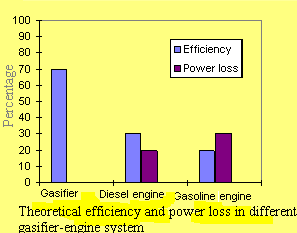
A typical composition of 4.5% CO 2 , 27 % CO, 14% H2 , 3 % CH 4 and 51% N 2 has a lower heating value of 5.7 MJ/m3 at normal ambient condition of 15o C and pressure of 1 atm . The stoichiometric gas-mixture has an energy density of 2.5 MJ/m3 compared to 3.5 MJ/m 3 for gasoline-air mixture and 3.3 MJ/m 3 diesel-air mixture.
Operational difference between
diesel and gasoline engine
There is significant difference between diesel and spark ignition engine system with respect to itīs suitability for producer gas. In diesel engine, diesel is injected at the end of compression stroke and get ignited immediately without any spark ignition. This will not the case with producer gas- air mixture. In fact, diesel engine cannot operate alone on producer gas as temperature and pressure is not sufficient to ignite gas-air mixture. Hence, during the injection of producer-gas mixture, some quantity of diesel is also injected in combustion chamber.
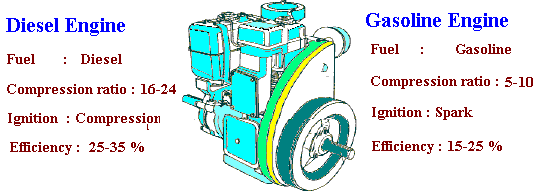
In gasoline engine, air-fuel mixture is sucked during suction stroke and mixture is ignited with a spark at the end of compression stroke. Gasoline engine running on producer gas can operate on producer gas alone without any injection of gasoline. This is certainly convenient in remote rural areas, where gasifier-engine system is used for power or electricity generation. In general, low speed engines with large displacement and combustion place have advantage over todayīs comact and high speed engines.
Conversion of gasoline engine to producer gas
Unaltered gasoline engine run with producer gas experiences the power loss of 30-50% depending upon the producer gas quality.
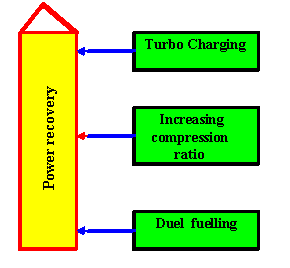 Unaltered gasoline engine run with producer gas sound good from economical point of view. This approach is beneficial, for some application such as irrigation pump, which works at constant load and even at low load also. This approach is not practically workable for tractor or any other automobile which has to work under different loading condition.
Unaltered gasoline engine run with producer gas sound good from economical point of view. This approach is beneficial, for some application such as irrigation pump, which works at constant load and even at low load also. This approach is not practically workable for tractor or any other automobile which has to work under different loading condition. In case already installed gasonline engine is converted to producer gas drive, some of the power can be recoverd through supercharging or turbocharging. The turbocharger would be required to deliver the gas-air mixture into existing unalatered engine at differential pressure of 1 atm to achieve equivalent of compression ratio increase from 5 to 10. This compression can be achieved by reciprocating type of pump. The power for pump shall be provided by turbine run on exhaust of engine.
Compression ratio
Power loss in gasoline engine run on producer gas be recovered by increasing the compression ratio. Commrecially built gas producers were usually operated at the compression ratio of 6.5 to 7.5. Keeping in mind hydrogen content in producer gas and itīs effect on flame speed, compression ratio as high as 10 is said to be technically and economical feasible. There are other operational problems with higher compression ratio. Engine with higher compression ratio are difficult to start, creates vibrations, increases wear and tear on piston, reducing the life of the system.
Gas-fuel mixture
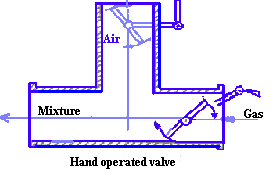 In the case of engine run on gasoline, gasoline-air mixture is adjusted automatically by carburetor and controlled by accelerator. Finding the correct gas-air ratio in producer gas drive engine is difficult as gas composition changes over a run, sometimes drastically. There are different kinds of valves ranging from simple hand operated valve to fully automatic valve for control of gas-air mixture.
In the case of engine run on gasoline, gasoline-air mixture is adjusted automatically by carburetor and controlled by accelerator. Finding the correct gas-air ratio in producer gas drive engine is difficult as gas composition changes over a run, sometimes drastically. There are different kinds of valves ranging from simple hand operated valve to fully automatic valve for control of gas-air mixture. 
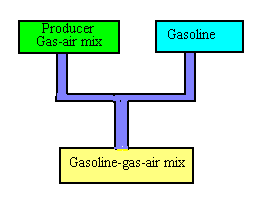 One of the most widely used and convernient method to increase the power output of engine is duel fuelling. Dual fuelling is good compromise between gasoline savings, conveninece and ease of operations. In dual fuelling, gas-air mixture is injected with small amounts of gasoline. Degree of dual fuelling depends upon the engine load and independence one need in use of producer gas. Three commonly used dual fuelling methods are :
One of the most widely used and convernient method to increase the power output of engine is duel fuelling. Dual fuelling is good compromise between gasoline savings, conveninece and ease of operations. In dual fuelling, gas-air mixture is injected with small amounts of gasoline. Degree of dual fuelling depends upon the engine load and independence one need in use of producer gas. Three commonly used dual fuelling methods are :- Dual fuelling on continuous basis, meaning small amounts of gasoline with gas-air mixture
- Starting the engine on gasoline and then switching over to producer gas drive
- Dual fuelling when additional power is needed to overcome the load, for instance, on hills
Conversion of diesel engine to producer gas
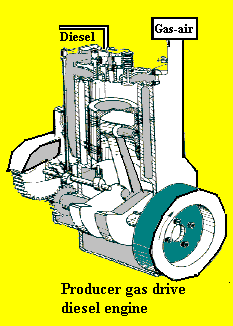 Diesel engines are compression ignition engines with compression ratio of 16-24 depending on whether they are direct combustion chamber, pre-combustion chamber, four strokes or two strokes. Fuel is ignited by high gas air temperature. As diesel engine cannot be operated on producer gas alone, it need to be operated on dual fuel or converted completely into spark ignition engine.
Diesel engines are compression ignition engines with compression ratio of 16-24 depending on whether they are direct combustion chamber, pre-combustion chamber, four strokes or two strokes. Fuel is ignited by high gas air temperature. As diesel engine cannot be operated on producer gas alone, it need to be operated on dual fuel or converted completely into spark ignition engine. Complete rebuilding of entire engine is expensive and time consuming job.
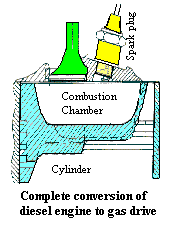 Power drop in diesel engine converted to spark ignition is not as sever as gasoline engine running on producer gas. In case of dual fuelling, modification is confined to a special induction manifold and gas-air mixer as converted in gasoline engines. The pilot injection of diesel amounted to 10 -25% of original consumption. For economical reason, it is best to inject the amount of diesel necessary for smooth operation of engine
Power drop in diesel engine converted to spark ignition is not as sever as gasoline engine running on producer gas. In case of dual fuelling, modification is confined to a special induction manifold and gas-air mixer as converted in gasoline engines. The pilot injection of diesel amounted to 10 -25% of original consumption. For economical reason, it is best to inject the amount of diesel necessary for smooth operation of engineTo retun to main page click here